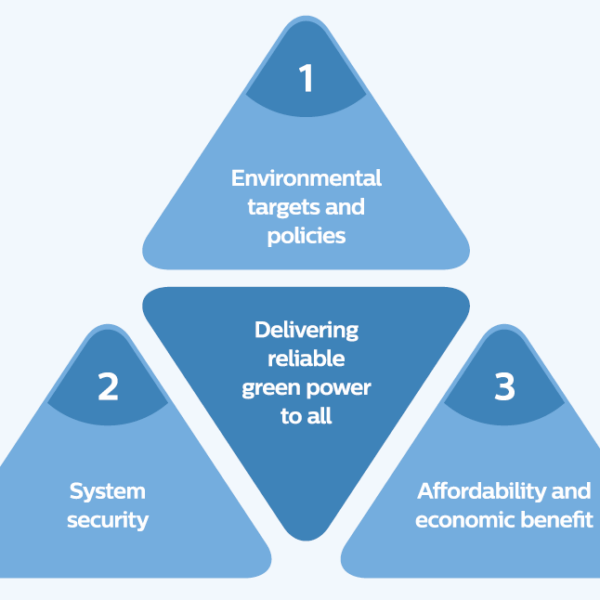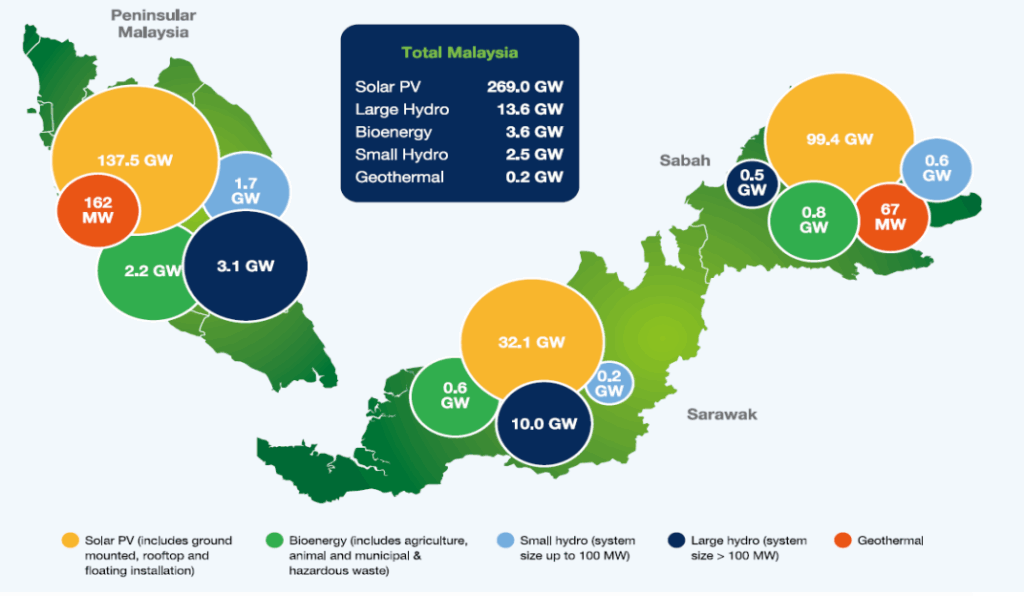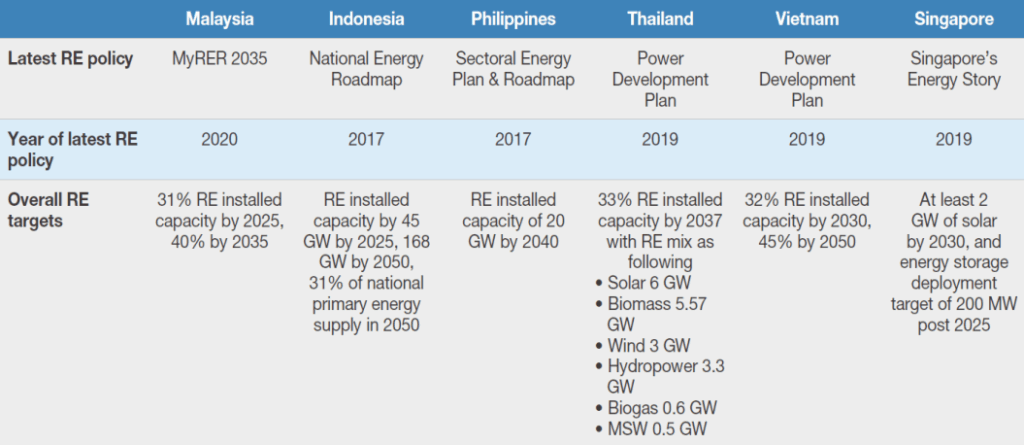Malaysia’s Renewable Energy Policy and its Impact on ASEAN Countries
Volume 9, Issue 2, Page No 67-73, 2024
Author’s Name: WaiYie Leong1,a), LeeSun Heng2, YuanZhi Leong2
View Affiliations
1 INTI International University, Persiaran Perdana BBN Putra Nilai, 71800 Nilai, Negeri Sembilan
2 Schneider Electric, 50 Kallang Ave, 339505, Singapore
a)whom correspondence should be addressed. E-mail: waiyie@gmail.com
Adv. Sci. Technol. Eng. Syst. J. 9(2), 67-73 (2024); ![]() DOI: 10.25046/aj090208
DOI: 10.25046/aj090208
Keywords: Renewable Energy Policy, Green Technology, Sustainable Development, Energy Efficiency
Export Citations
As the global community increasingly shifts its focus towards sustainable development and combating climate change, renewable energy policies have become pivotal in shaping national and regional energy landscapes. Malaysia, as a developing nation with a rapidly growing economy, has recognized the importance of renewable energy sources in achieving its socio-economic goals while addressing environmental concerns. This paper explores Malaysia’s renewable energy policy framework and assesses its impact on neighboring countries in the Southeast Asian region. Through a comprehensive analysis of policy measures, incentives, challenges, and achievements, this paper elucidates the significance of Malaysia’s renewable energy endeavors in fostering regional energy security, sustainability, and cooperation.
Received: 08 February 2024, Revised: 17 April 2024, Accepted: 18 April 2024, Published Online: 30 April 2024
1. Introduction
In the face of global climate change and the need for sustainable development, countries worldwide are increasingly turning towards renewable energy sources. Malaysia, a rapidly developing nation in Southeast Asia, has recognized the importance of renewable energy in its energy transition. The Malaysian government has implemented various policies and initiatives to promote renewable energy adoption, aiming not only to meet domestic energy needs but also to have a positive impact on the region’s energy landscape [1-2]. This paper examines Malaysia’s renewable energy policy framework and analyzes its impact on neighboring countries in the region.
1.1. Malaysia’s Renewable Energy Policy Framework
Malaysia’s journey towards renewable energy adoption began with the enactment of the Renewable Energy Act in 2011 [1]. This legislation laid the groundwork for various initiatives aimed at promoting renewable energy development. The key components of Malaysia’s renewable energy policy framework include:
- National Renewable Energy Policy and Action Plan: The Malaysian government formulated a comprehensive National Renewable Energy Policy and Action Plan, outlining targets and strategies for renewable energy deployment. This policy framework provides a roadmap for transitioning towards a more sustainable energy mix [2].
- Feed-in Tariff (FiT) Mechanism: The FiT mechanism, introduced in 2011, offers attractive tariffs to renewable energy producers, thereby incentivizing investment in solar, biomass, and biogas projects. This policy has stimulated significant growth in renewable energy capacity across Malaysia.
- Net Energy Metering (NEM) Scheme: The NEM scheme allows renewable energy system owners to offset their electricity bills by exporting excess energy to the grid [3]. This initiative encourages the adoption of rooftop solar systems among residential, commercial, and industrial consumers.
- Renewable Energy Fund: The government has established a Renewable Energy Fund to support research, development, and deployment of renewable energy technologies [4]. This fund facilitates innovation and capacity building within the renewable energy sector.
The implementation of Malaysia’s renewable energy policies has not only transformed its domestic energy landscape but also had significant implications for neighboring countries in the region.
2. Literature Review of Malaysia’s Renewable Energy Policy
Malaysia, a country in Southeast Asia, has been actively pursuing renewable energy initiatives to address energy security concerns, reduce dependency on fossil fuels, and mitigate climate change. This section provides a historical overview and literature review of Malaysia’s renewable energy policy development and its impact on neighboring countries in the region.

Malaysia’s interest in renewable energy dates back to the early 2000s when the government recognized the need for sustainable energy development [1,5]. Key milestones include the establishment of the National Renewable Energy Policy and Action Plan in 2009, which set targets for renewable energy adoption and introduced policy mechanisms such as Feed-in Tariffs (FiT) and Net Energy Metering (NEM). Subsequent revisions and updates to the policy framework have aimed to accelerate renewable energy deployment and attract investment in the sector. Malaysia’s renewable energy targets have been incorporated into national development plans, demonstrating the government’s commitment to transitioning towards a low-carbon economy.
Numerous studies have examined various aspects of Malaysia’s renewable energy policy and its impact on the region. Research has focused on the effectiveness of policy instruments such as FiT and NEM in incentivizing renewable energy investment and deployment. Scholars have also explored the potential of different renewable energy sources, including solar, wind, biomass, and hydro, in Malaysia’s energy transition. Assessments of Malaysia’s renewable energy market dynamics, investment climate, and regulatory framework have provided insights into the challenges and opportunities facing the sector.
The impact of Malaysia’s renewable energy policy extends beyond its borders, influencing regional energy dynamics and cooperation. Enhanced regional energy security is achieved through diversified energy sources and reduced reliance on imported fossil fuels. Economic opportunities arise from cross-border investment and collaboration in renewable energy projects, fostering regional integration and development. Knowledge sharing and technology transfer initiatives contribute to capacity building and sustainable energy development in neighboring countries. Malaysia’s leadership in renewable energy policy serves as a model for regional peers, influencing the formulation of renewable energy strategies and policies across Southeast Asia.
Malaysia’s renewable energy policy has undergone significant development over the years, shaping the country’s energy landscape and influencing regional energy dynamics. Through policy initiatives, incentives, and collaborations, Malaysia has made strides towards a more sustainable and resilient energy future. Continued research and cooperation among regional countries are essential for advancing renewable energy adoption and achieving shared climate and energy goals.
3. MyRER: Malaysia Renewable Energy Roadmap
The Malaysia Renewable Energy Roadmap (MyRER) is a strategic plan developed by the Malaysian government to promote the growth and adoption of renewable energy sources in the country. It aims to diversify Malaysia’s energy mix, reduce dependence on fossil fuels, and mitigate the environmental impacts of energy generation.
Key objectives of MyRER typically include:
- Increasing Renewable Energy Capacity: Setting targets for the installation of renewable energy capacity, such as solar, wind, hydroelectric, biomass, and biogas power plants.

- Policy and Regulatory Framework: Developing supportive policies, regulations, and incentives to attract investment in renewable energy projects and streamline approval processes.
- Infrastructure Development: Investing in the necessary infrastructure, such as grid upgrades and energy storage facilities, to support the integration of renewable energy into the existing power system.
- Research and Development: Encouraging research and development efforts to improve renewable energy technologies, reduce costs, and enhance efficiency.
MyRER serves as a guiding framework for the Malaysian government and stakeholders in the renewable energy sector to work towards sustainable energy development and achieve national energy security goals. It typically outlines specific targets, timelines, and action plans to monitor progress and ensure the successful implementation of renewable energy initiatives.
- Capacity Building and Awareness: Providing training programs, workshops, and public awareness campaigns to build capacity and promote the benefits of renewable energy adoption.
- Collaboration and Partnerships: Fostering collaboration between government agencies, private sector entities, academia, and international organizations to achieve the goals of the roadmap.
4. MyRER: The Milestones and Aspirations
The Malaysia Renewable Energy Roadmap (MyRER) typically outlines a series of milestones and aspirations to guide the country’s transition towards a more sustainable and renewable energy future. These milestones and aspirations may vary depending on the specific version or iteration of MyRER, as well as evolving national priorities and goals. However, here are some common milestones and aspirations that could be included:
- Setting Renewable Energy Targets: Establishing ambitious targets for the deployment of renewable energy capacity in Malaysia, including targets for solar, wind, hydroelectric, biomass, and biogas power generation.
- Policy and Regulatory Reforms: Implementing policy and regulatory reforms to create a conducive environment for renewable energy investment, such as feed-in tariffs, net metering schemes, renewable energy auctions, and streamlined permitting processes.
- Infrastructure Development: Investing in grid infrastructure upgrades, energy storage facilities, and smart grid technologies to support the integration of variable renewable energy sources into the electricity grid.
- Promotion of Solar Energy: Encouraging the widespread adoption of solar photovoltaic (PV) systems, including rooftop solar installations on residential, commercial, and industrial buildings, as well as utility-scale solar farms.
- Expansion of Wind Power: Identifying and developing suitable sites for wind energy projects, particularly in coastal and high-wind areas, to harness Malaysia’s wind energy potential.
- Hydropower Development: Continuing to develop hydropower projects in a sustainable manner, balancing energy generation with environmental and social considerations.
- Biomass and Biogas Utilization: Promoting the use of biomass and biogas for electricity generation, industrial processes, and transportation fuels, leveraging Malaysia’s abundant agricultural and organic waste resources.
- Research and Innovation: Investing in research and innovation to drive down the costs of renewable energy technologies, improve efficiency, and address technical challenges.
- Capacity Building and Education: Providing training programs, workshops, and educational initiatives to build local expertise and raise awareness about the benefits of renewable energy.
- International Collaboration: Collaborating with international partners, organizations, and experts to share best practices, technology transfer, and financial assistance for renewable energy projects.
- These milestones and aspirations are typically designed to accelerate the transition towards a more sustainable, low-carbon energy system in Malaysia, while also promoting economic growth, energy security, and environmental stewardship. Regular monitoring and evaluation of progress are essential to ensure that MyRER goals are being met and to make adjustments as needed to stay on track.
5. MyRER: The Strategic Framework
The strategic framework of the Malaysia Renewable Energy Roadmap (MyRER) typically encompasses a comprehensive approach to advancing renewable energy deployment and achieving sustainability goals [1,5]. While the specific details may vary, depending on the version and iteration of MyRER, the strategic framework generally includes the following key components:
- Policy and Regulatory Environment: Establishing a supportive policy and regulatory framework that incentivizes investment in renewable energy and facilitates its integration into the energy market [6]. This may include feed-in tariffs, renewable energy quotas, net metering schemes, tax incentives, and streamlined permitting processes.
- Market Development and Financing: Stimulating market demand for renewable energy through mechanisms such as renewable energy auctions, power purchase agreements (PPAs), green procurement policies, and financial incentives for renewable energy projects [7]. Access to financing, including loans, grants, and venture capital, is also crucial for accelerating renewable energy deployment.
- Infrastructure and Grid Integration: Investing in grid infrastructure upgrades, energy storage systems, and smart grid technologies to accommodate the variability and intermittency of renewable energy sources [8]. This includes grid expansion to remote areas with high renewable energy potential and implementing grid codes and standards to ensure the reliable and efficient operation of the grid with increased renewable energy penetration.
- Resource Assessment and Planning: Conducting comprehensive resource assessments to identify and prioritize renewable energy sources, such as solar, wind, hydroelectric, biomass, and biogas, with the greatest potential for development. Long-term energy planning, including scenario analysis and forecasting, is essential for guiding investment decisions and optimizing the mix of renewable energy technologies [9].
- development, and innovation in renewable energy technologies to improve efficiency, reduce costs, and address technical challenges. This includes funding for research institutions, technology demonstration projects, and collaborative R&D initiatives with industry partners.
- Capacity Building and Human Capital Development: Building local expertise and technical skills in renewable energy development, operation, and maintenance through training programs, education initiatives, and partnerships with academic institutions and industry associations. This includes vocational training, professional certification programs, and knowledge sharing platforms to enhance workforce readiness and competency.
- Public Awareness and Stakeholder Engagement: Raising awareness among policymakers, businesses, communities, and the general public about the benefits of renewable energy, including environmental sustainability, energy security, job creation, and economic development. Engaging stakeholders through consultations, workshops, and outreach activities fosters support for renewable energy policies and projects.
- Monitoring, Evaluation, and Review Mechanisms: Establishing robust monitoring, evaluation, and review mechanisms to track progress towards renewable energy targets, assess the effectiveness of policy measures, and identify areas for improvement. Regular performance monitoring and reporting ensure accountability and enable evidence-based decision-making to optimize the implementation of MyRER initiatives.
By addressing these strategic elements, MyRER aims to create an enabling environment for scaling up renewable energy deployment, driving sustainable economic growth, and mitigating climate change impacts in Malaysia. The strategic framework provides a roadmap for coordinated action by government agencies, private sector stakeholders, civil society organizations, and international partners to achieve shared renewable energy goals and objectives.

6. Growth Of Primary Energy Demand Is Expected To Decline
A decline in the growth of primary energy demand suggests a significant shift in energy consumption trends, typically influenced by various factors:
- Energy Efficiency Measures: Increased adoption of energy-efficient technologies and practices across sectors like industry, transportation, and buildings can lead to reduced energy consumption per unit of economic output. Investments in energy-efficient appliances, vehicles, and infrastructure contribute to this decline in demand growth.
- Renewable Energy Integration: The expanding deployment of renewable energy sources such as solar, wind, hydroelectric, and biomass can displace traditional fossil fuels for electricity generation and other energy needs. As renewable energy becomes more competitive and accessible, it can curb the growth of primary energy demand.
- Economic Changes: Structural shifts in economies, such as a transition towards service-based industries or improvements in industrial processes, can affect energy demand. Economic diversification, coupled with technological advancements, can lead to more energy-efficient production methods and reduced energy intensity.
- Policy and Regulatory Measures: Government policies and regulations aimed at promoting energy conservation, reducing greenhouse gas emissions, and increasing renewable energy deployment play a crucial role. Measures such as energy efficiency standards, carbon pricing mechanisms, renewable energy targets, and subsidies for clean energy technologies incentivize energy savings and renewable energy adoption.
- Technological Innovations: Ongoing advancements in energy technologies, including energy storage, smart grids, and electrification of transportation, contribute to the decline in energy demand growth. Innovations in energy management systems, automation, and digitization optimize energy use and improve overall efficiency.
- Changing Consumer Behavior: Increasing awareness of environmental issues and sustainability, coupled with changing consumer preferences, can drive demand for energy-efficient products and services. Lifestyle changes, such as the adoption of public transportation, cycling, and telecommuting, also contribute to reducing energy demand growth.
- Global Trends: Global initiatives to address climate change, such as the Paris Agreement, and the growing recognition of the importance of sustainable development influence energy policies and investment decisions. International cooperation and commitments towards decarbonization further accelerate the transition towards cleaner and more efficient energy systems.
- A decline in the growth of primary energy demand reflects efforts to decouple economic growth from energy consumption, promote sustainable development, and mitigate climate change. However, achieving sustained reductions in energy demand growth requires continued investment, innovation, and policy support across multiple sectors and stakeholders.
7. ASEAN: Increasingly Aggressive Renewable Energy Targets
The Association of Southeast Asian Nations (ASEAN) has indeed been increasingly aggressive in setting renewable energy targets in recent years. This trend reflects the region’s commitment to promoting sustainable development, enhancing energy security, and mitigating climate change. Several factors contribute to ASEAN’s growing focus on renewable energy [1,5-6]:
- Energy Security Concerns: ASEAN member states recognize the importance of diversifying their energy sources to reduce dependence on fossil fuels and enhance energy security. Investing in renewable energy helps mitigate risks associated with energy supply disruptions and price volatility [7-8].
- Climate Change Mitigation: ASEAN countries are vulnerable to the impacts of climate change, including extreme weather events, sea-level rise, and disruption of agricultural systems. By transitioning to renewable energy sources, ASEAN aims to reduce greenhouse gas emissions and contribute to global efforts to limit temperature rise and mitigate climate change impacts.
- Economic Opportunities: The rapid growth of renewable energy markets presents significant economic opportunities for ASEAN countries. By investing in renewable energy infrastructure and technologies, ASEAN can stimulate job creation, attract investment, and promote industrial development, particularly in the manufacturing and services sectors.
- Technological Advancements: Advances in renewable energy technologies, coupled with declining costs, have made renewable energy increasingly competitive with conventional fossil fuels. ASEAN member states can leverage these technological advancements to accelerate the deployment of renewable energy projects and achieve their targets cost-effectively[9-10].
- Policy Support and Regional Cooperation: ASEAN has established frameworks and mechanisms to support renewable energy development, including the ASEAN Plan of Action for Energy Cooperation (APAEC) and the ASEAN Centre for Energy (ACE). These initiatives facilitate policy dialogue, capacity building, and knowledge sharing among member states to promote renewable energy deployment.
- International Commitments: ASEAN member states are signatories to international agreements and initiatives aimed at promoting renewable energy and sustainable development, such as the Paris Agreement and the United Nations Sustainable Development Goals (SDGs). Meeting renewable energy targets aligns with ASEAN’s broader commitments to these global initiatives [11-12].
- Public Awareness and Support: There is growing public awareness and support for renewable energy across ASEAN countries. Concerns about air pollution, environmental degradation, and the health impacts of fossil fuel combustion have fueled demand for cleaner and more sustainable energy solutions.


ASEAN’s increasingly aggressive renewable energy targets underscore the region’s commitment to transitioning towards a low-carbon and sustainable energy future. By harnessing the abundant renewable energy resources available in the region and leveraging technological innovations and policy support, ASEAN aims to achieve its renewable energy goals while promoting economic growth, energy security, and environmental sustainability.
8. Conclusions
Malaysia’s Renewable Energy Policy has been a significant driver in promoting the adoption of renewable energy sources within the country, with ripple effects impacting neighboring regional countries. The policy framework, encapsulated in initiatives such as the Malaysia Renewable Energy Act and the National Renewable Energy Policy and Action Plan, sets ambitious targets for renewable energy capacity expansion and outlines various mechanisms to incentivize investment and deployment.
One key impact of Malaysia’s Renewable Energy Policy on regional countries is the demonstration effect. As Malaysia implements and showcases successful renewable energy projects, it serves as a model for other countries in the region, inspiring them to pursue similar initiatives. This influence is particularly significant for ASEAN member states, given Malaysia’s active participation and leadership within the ASEAN community.
Furthermore, Malaysia’s efforts in renewable energy development contribute to regional energy security by diversifying the energy mix and reducing reliance on imported fossil fuels. This resilience is especially crucial for countries in Southeast Asia, which face geopolitical and supply chain risks associated with traditional energy sources.
Additionally, Malaysia’s growing expertise and capabilities in renewable energy technology and project development offer opportunities for regional collaboration and knowledge exchange. Through partnerships, capacity-building initiatives, and joint ventures, neighboring countries can leverage Malaysia’s experience to accelerate their own renewable energy transitions.
Moreover, Malaysia’s Renewable Energy Policy contributes to the region’s collective efforts in combating climate change. By reducing greenhouse gas emissions and promoting sustainable development practices, Malaysia sets a positive example for regional cooperation on climate action, aligning with international commitments such as the Paris Agreement.
Malaysia’s Renewable Energy Policy has a multifaceted impact on regional countries, serving as a catalyst for renewable energy adoption, enhancing energy security, fostering collaboration, and advancing climate mitigation efforts across Southeast Asia. As Malaysia continues to progress in its renewable energy journey, its influence on the region’s energy landscape is likely to grow, driving a more sustainable and resilient future for all.
Conflict of Interest
The authors declare no conflict of interest.
- Malaysia Renewable Energy Roadmap: Pathway Towards Low Carbon Energy System , SEDA Malaysia, 2021. https://www.seda.gov.my/reportal/myrer/
- R. Kumar, V. Jain, W. Y. Leong, S. Teyarachakul, Convergence of IoT, Blockchain, and Computational Intelligence in Smart Cities. CRC Press, 2023, DOI: 10.1201/9781003353034
- W. Y. Leong, Y. Z. Leong, W. S. Leong, “Smart Manufacturing Technology for Environmental, Social, and Governance (ESG) Sustainability”. In Proc. 2023 IEEE 5th Eurasia Conference on IOT, Communication and Engineering (ECICE), 1-6, 2023, DOI: 10.1109/ECICE59523.2023.10383150
- W. Y. Leong, “Investigating and Enhancing Energy Management Policy and Strategies in ASEAN,” 2023 Asia Meeting on Environment and Electrical Engineering (EEE-AM), Hanoi, Vietnam, 1-6, 2023, doi: 10.1109/EEE-AM58328.2023.10395060
- W. Y. Leong, L. S. Heng, Y. Z. Leong, “Malaysia renewable energy policy and its impact on regional countries”. In Proc. 12th International Conference on Renewable Power Generation (RPG 2023), 7-13, 2023, DOI: 10.1049/icp.2023.2114
- W. Y. Leong, Y. Z. Leong, W. S. Leong, “Green Building Initiatives in ASEAN Countries”. In Proc. 2023 Asia Meeting on Environment and Electrical Engineering (EEE-AM), 1-6, 2023, DOI: 10.1109/EEE-AM58328.2023.10395261
- W. Y. Leong, “Digital Technology for Asean Energy,” 2023 International Conference on Circuit Power and Computing Technologies (ICCPCT), Kollam, India, 1480-1486, 2023, DOI: 10.1109/ICCPCT58313.2023.10244806
- W. Y. Leong, Y. Z. Leong, W. S. Leong, “Accelerating the Energy Transition via 3D Printing,” 2023 Asia Meeting on Environment and Electrical Engineering (EEE-AM), Hanoi, Vietnam, 01-05, 2023, doi: 10.1109/EEE-AM58328.2023.10395773
- F. M. Han, W. Y. Leong, “Investigating Target Detection and Localization in Wireless Sensor Network”, Procedia Engineering, 41: 75-81, 2012, DOI:10.1016/j.proeng.2012.07.145
- W. Y. Leong, R. Kumar, “5G Intelligent Transportation Systems for Smart Cities”, Convergence of IoT, Blockchain, and Computational Intelligence in Smart Cities, CRC Press, 1-25, 2023, DOI: 10.1201/9781003353034-1
- W. Y. Leong, L. S. Heng, Y. Z. Leong, “Smart city initiatives in Malaysia and Southeast Asia”, IET Conference Proceedings, 2023, 1143-1149, DOI: 10.1049/icp.2023.2440
- W. Y. Leong, “ASEAN Federation of Engineering Organisations (AFEO) midterm meeting in Hanoi”, Jurutera Bulletin, The Institution of Engineers, Malaysia (IEM), 35-36, 2016.
Citations by Dimensions
Citations by PlumX
Crossref Citations
- Wai Yie Leong, Yuan Zhi Leong, Wai San Leong, "Nuclear Technology in Electronic Communications." In 2024 IEEE 4th International Conference on Electronic Communications, Internet of Things and Big Data (ICEIB), pp. 684, 2024.
- Wai Yie Leong, Yuan Zhi Leong, Wai San Leong, "Green Policies and Programmes in ASEAN." In 2024 9th International Conference on Applying New Technology in Green Buildings (ATiGB), pp. 422, 2024.
- Wai Yie Leong, Yuan Zhi Leong, Wai San Leong, "Virtual Reality In Green Construction." In 2024 9th International Conference on Applying New Technology in Green Buildings (ATiGB), pp. 449, 2024.
